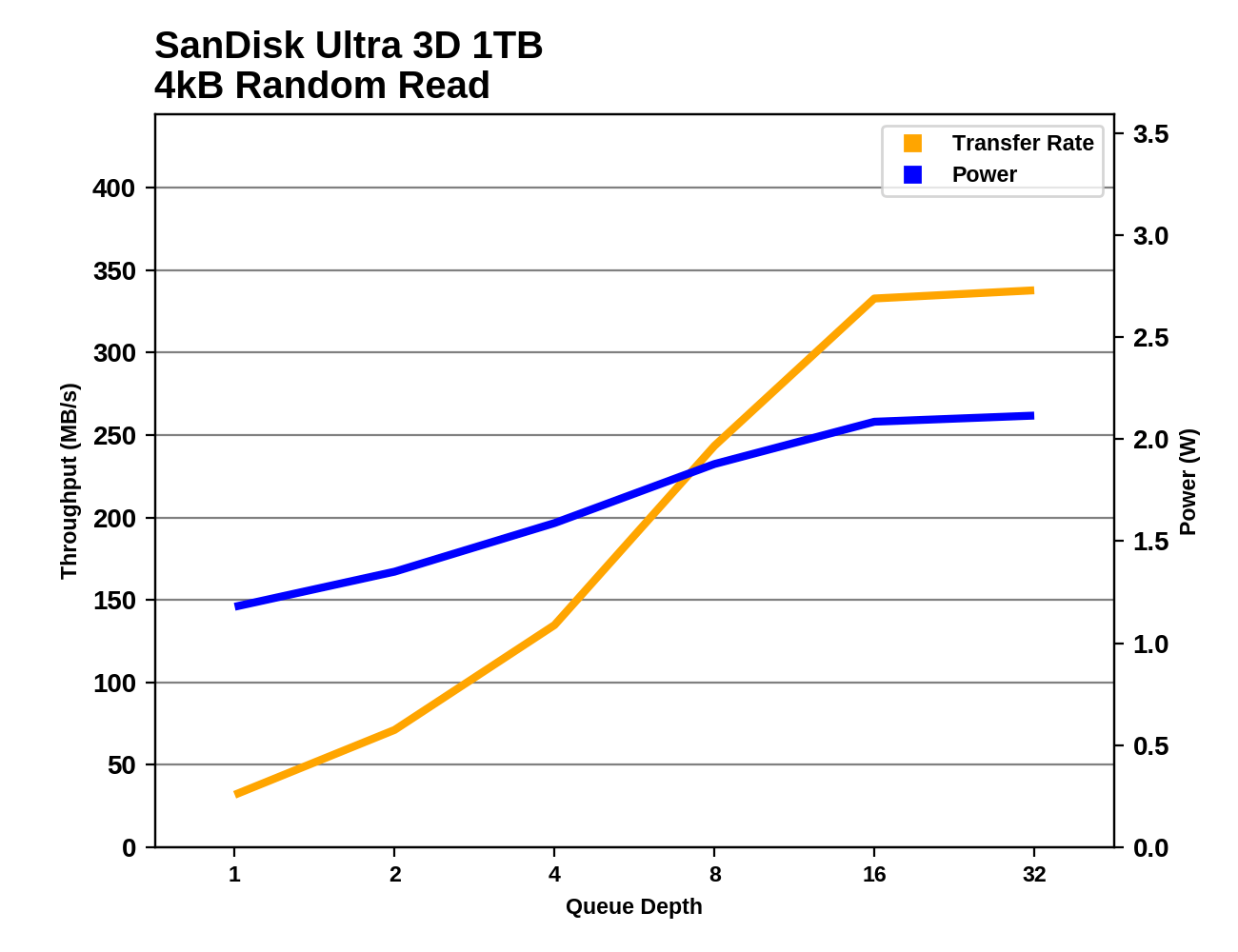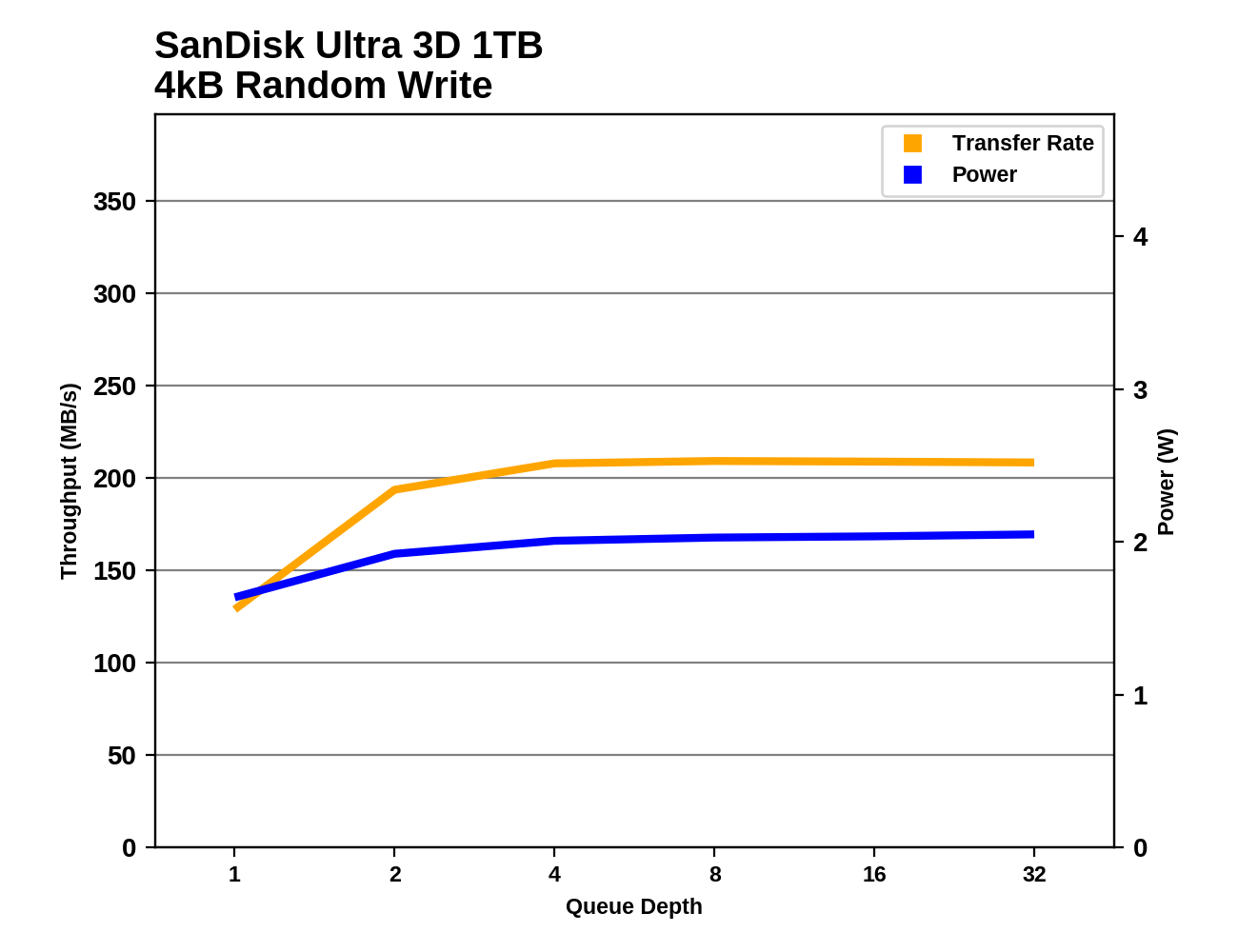One Design, Two Products: The SanDisk Ultra 3D (1TB) and WD Blue 3D (1TB) SSD Reviews, with BiCS 3D NAND
by Billy Tallis on September 14, 2017 9:00 AM ESTRandom Read Performance
Our first test of random read performance uses very short bursts of operations issued one at a time with no queuing. The drives are given enough idle time between bursts to yield an overall duty cycle of 20%, so thermal throttling is impossible. Each burst consists of a total of 32MB of 4kB random reads, from a 16GB span of the disk. The total data read is 1GB.

Orange is for the new drives, Blue is for the previous generation models
The switch to 3D NAND gives a clear boost to the random read performance of Western Digital's SSDs. The WD Blue was already in second place, but it has now narrowed the Samsung 850 PRO's lead.
Our sustained random read performance is similar to the random read test from our 2015 test suite: queue depths from 1 to 32 are tested, and the average performance and power efficiency across QD1, QD2 and QD4 are reported as the primary scores. Each queue depth is tested for one minute or 32GB of data transferred, whichever is shorter. After each queue depth is tested, the drive is given up to one minute to cool off so that the higher queue depths are unlikely to be affected by accumulated heat build-up. The individual read operations are again 4kB, and cover a 64GB span of the drive.

The performance boost from 3D NAND doesn't disappear on the longer random read test: the new Western Digital SSDs are able to hold on to second place, this time much closer to the Samsung 850 PRO in performance.

The WD/SanDisk drives already had great power efficiency for random reads, but the 3D NAND improves it even more. The Intel 545s still has the clear lead, but it isn't such a wide margin anymore.
 |
|||||||||
The performance scaling behavior of the SanDisk Ultra 3D and WD Blue 3D NAND are quite similar to other top-performing drives, with performance mostly saturated by QD16. The power consumption is much lower and scales more gradually than on Samsung's drives.
Random Write Performance
Our test of random write burst performance is structured similarly to the random read burst test, but each burst is only 4MB and the total test length is 128MB. The 4kB random write operations are distributed over a 16GB span of the drive, and the operations are issued one at a time with no queuing.

The older WD/SanDisk drives had some trouble with QD1 burst random write performance, but the new 3D NAND drives are as fast as any other TLC SATA SSDs on this test, and not too far behind the 3D MLC drives.
As with the sustained random read test, our sustained 4kB random write test runs for up to one minute or 32GB per queue depth, covering a 64GB span of the drive and giving the drive up to 1 minute of idle time between queue depths to allow for write caches to be flushed and for the drive to cool down.

On the longer test that brings in higher queue depths, the WD and SanDisk drives still fare poorly even with 3D NAND. Toshiba manages to deliver a better score with their OCZ Trion 150 using 15nm planar TLC, even though the Trion 150 was in last place for QD1 random write performance.

In spite of poor performance, the WD and SanDisk 3D NAND drives have good power efficiency that is on par with Samsung, but behind the Intel and Micron 3D NAND SSDs.
 |
|||||||||
Most of these SSDs reach their full random write performance by QD4 and don't gain anything from higher queue depths. The WD Blue 3D NAND and SanDisk Ultra 3D fit this description too, but with a remarkably sub-par performance at saturation.










52 Comments
View All Comments
TheinsanegamerN - Sunday, September 17, 2017 - link
Talk about mountains and molehills.the "performance bottlenecks" of SATA III are only of concern to .01% of buyers. For most tasks, your network interface will be the bottleneck. And when sata IS the bottleneck, the difference between PCIE and SATA are minimal at best.
As for price, I agree that prices are high, but I also know that, having built multiple SSD machines, you are overblowing the issue. 512GB drives can be had for $100 on sale, and that is more storage then 90% of users need.
A drive capable of 500MB/s speeds is hardly low performance.
Magichands8 - Sunday, September 17, 2017 - link
Actually SATA bottlenecks should be of concern for anyone who has to wait for their data to be moved, recovered or otherwise accessed. Which can easily happen if anyone transfers anything on the order of a few gigabytes. It's especially concerning when those bottlenecks are imposed by borderline obsolete technology which is absolutely, completely unnecessary. And the response as to why always seems to be "just because" as if in defense of tech companies dragging their asses. One of the reasons why SSDs were adopted as slowly as they were is because most users weren't even aware of the benefits. For people just checking their Facebook and reading e-mails why even care about SATA III? Just stick with SATA I. Or better yet just ignore SSDs all together and stick with spinning rust. Or hell just use a 15 year old computer. Or by a $200 smart phone and bypass computers all together. More and more it's the case that a smartphone is 'good enough' for most people such that more and more of those of us with actual computers are going to run into the limitations of SATA III. There's just no excuse. I'm aware of the better technology which is one of the reasons why I ignore every SSD release like these here with specs no different than any other SSD. Like I said, if someone is in desperate need of a replacement drive it makes some sense but by and large these releases are pointless. Companies SHOULD have an interest in giving us a reason to upgrade, a reason to buy their products.Slaveguy - Thursday, September 14, 2017 - link
You're crippled by your twisted little kid leg, slaveMajGenRelativity - Thursday, September 14, 2017 - link
What?MrSpadge - Thursday, September 14, 2017 - link
What's a "wrong" form factor, then?Bullwinkle J Moose - Thursday, September 14, 2017 - link
" the SanDisk Ultra 3D is a long-overdue replacement for the Ultra II. Both of the new products use the same technology under the hood; they differ primarily in the stickers on the outside of the drive and the retail packaging it arrives in. "-----------------------------------------------------------------------------------------------------------------------------------
Yup, those new stickers are long overdue!
MajGenRelativity - Thursday, September 14, 2017 - link
The comment on the same tech is in comparison to the WD Blue 3D. The Ultra 3D is clearly different from the Ultra 2kmmatney - Thursday, September 14, 2017 - link
I bought my 1TB Ultra II 3 years ago for $219 - still running great. What is long overdue is lower pricing.ddhelmet - Thursday, September 14, 2017 - link
Why buy this over 850 EVO for 250 and 500 GB? They're both the same price.MajGenRelativity - Thursday, September 14, 2017 - link
Higher endurance and lower power consumption are the advantages the article mentions.